Grade 12 Exam > Grade 12 Notes > Biology for Grade 12 > Proteins
Proteins | Biology for Grade 12 PDF Download
Amino Acids & the Peptide Bond
Proteins
- Proteins are polymers (and macromolecules) made of monomers called amino acids
- The sequence, type and number of the amino acids within a protein determines its shape and therefore its function
- Proteins are extremely important in cells because they form all of the following:
- Enzymes
- Cell membrane proteins (eg. carrier)
- Hormones
- Immunoproteins (eg. immunoglobulins)
- Transport proteins (eg. haemoglobin)
- Structural proteins (eg. keratin, collagen)
- Contractile proteins (eg. myosin)
Amino acid
- Amino acids are the monomers of proteins
- There are 20 amino acids found in proteins common to all living organisms
- The general structure of all amino acids is a central carbon atom bonded to:
- An amine group -NH2
- A carboxylic acid group -COOH
- A hydrogen atom
- An R group (which is how each amino acid differs and why amino acid properties differ e.g. whether they are acidic or basic or whether they are polar or non-polar)

The generalised structure of an amino acid
Peptide bond
- In order to form a peptide bond a hydroxyl (-OH) is lost from the carboxylic group of one amino acid and a hydrogen atom is lost from the amine group of another amino acid
- The remaining carbon atom (with the double-bonded oxygen) from the first amino acid bonds to the nitrogen atom of the second amino acid
- This is a condensation reaction so water is released
- Dipeptides are formed by the condensation of two amino acids
- Polypeptides are formed by the condensation of many (3 or more) amino acids
- A protein may have only one polypeptide chain or it may have multiple chains interacting with each other
- During hydrolysis reactions, the addition of water breaks the peptide bonds resulting in polypeptides being broken down to amino acids
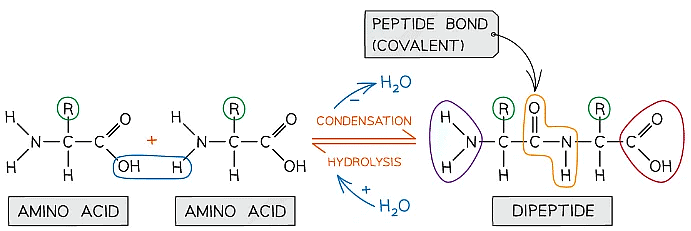
Amino acids are bonded together by covalent peptide bonds to form a dipeptide in a condensation reaction
Chromatography: Amino Acids
- Chromatography is a technique that can be used to separate a mixture into its individual components
- Chromatography relies on differences in the solubility of the different chemicals (called ‘solutes’) within a mixture
- All chromatography techniques use two phases:
- The mobile phase
- The stationary phase
- The components in the mixture separate as the mobile phase travels over the stationary phase
- Differences in the solubility of each component in the mobile phase which affects how far each component can travel
- Those components with higher solubility will travel further than the others
- This is because they spend more time in the mobile phase and are thus carried further up the paper than the less soluble components
Paper Chromatography
- Paper chromatography is one specific form of chromatography
- In paper chromatography:
- The mobile phase is the solvent in which the sample molecules can move, which in paper chromatography is a liquid e.g. water or ethanol
- The stationary phase in paper chromatography is the chromatography paper
Paper chromatography method
- A spot of the mixture (that you want to separate) is placed on chromatography paper and left to dry
- The chromatography paper is then suspended in a solvent
- As the solvent travels up through the chromatography paper, the different components within the mixture begin to move up the paper at different speeds
- Larger molecules move slower than smaller ones
- This causes the original mixture to separate out into different spots or bands on the chromatography paper
- This produces what is known as a chromatogram
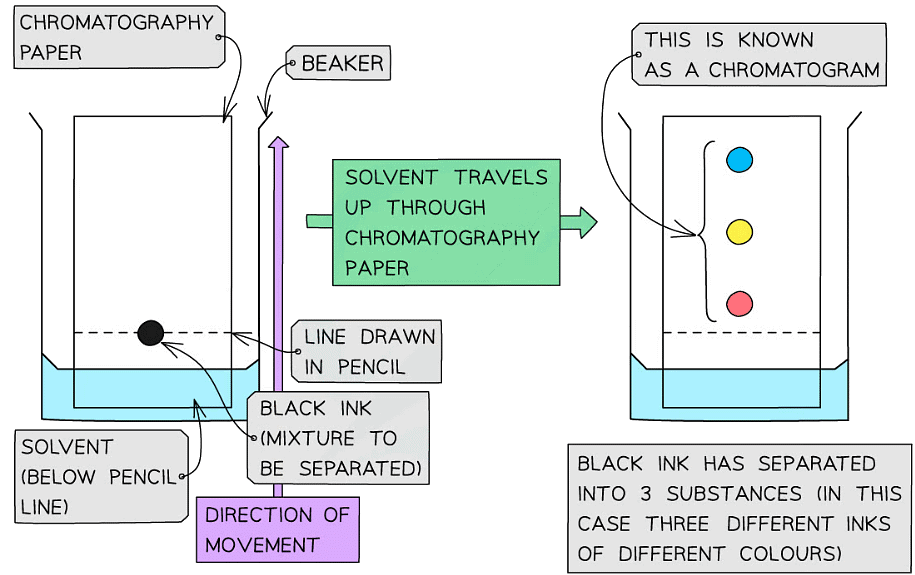
An example of a chromatogram that has been produced by using paper chromatography to separate a spot of ink
Using chromatography to separate a mixture of Amino Acids
- Paper chromatography can be used to separate a mixture of amino acids
- A spot of the unknown amino acid sample mixture is placed on a line at the bottom of the chromatography paper
- Spots of known standard solutions of different amino acids are then placed on the line beside the unknown sample spot
- The chromatography paper is then suspended in a solvent
- Each amino acid will be more or less soluble in the mobile phase than others and will therefore separate out of the mixture travelling with the solvent at different times/distances from the line, depending on their:
- Charge
- Size
- The unknown amino acid(s) can then be identified by comparing and matching them with the chromatograms of the known standard solutions of different amino acids
- If a spot from the amino acid sample mixture is at the same distance from the line as a spot from one the known standard solutions, then the mixture must contain this amino acid
- In order to view the spots from the different amino acids, it may be necessary to first dry the chromatography paper and then spray it with ninhydrin solution (this chemical reacts with amino acids, producing an easily visible blue-violet colour)
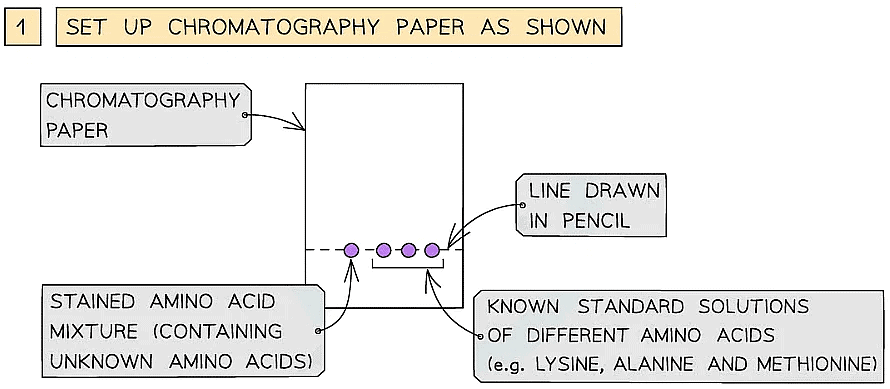
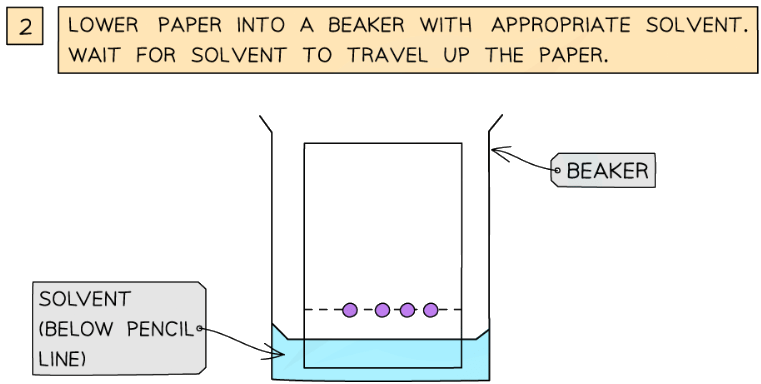
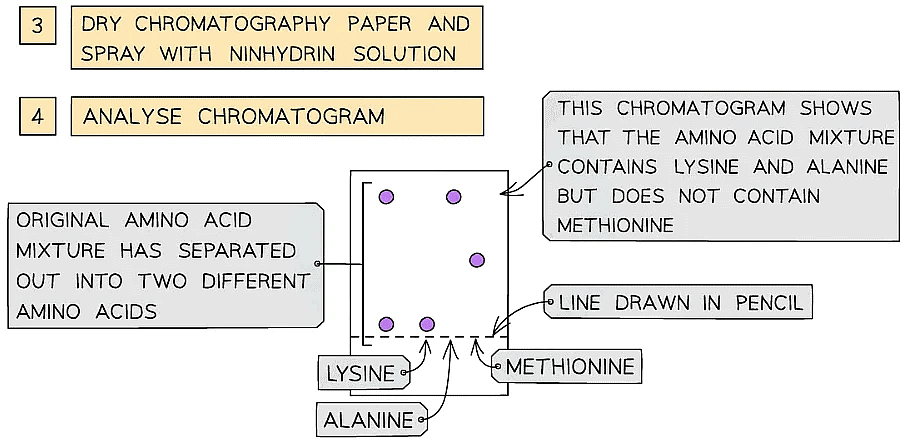
How chromatography can be used to separate a mixture of amino acids and identify the individual components
Proteins: Structures & Functions
- There are four levels of structure in proteins, three are related to a single polypeptide chain and the fourth level relates to a protein that has two or more polypeptide chains
- Polypeptide or protein molecules can have anywhere from 3 amino acids (Glutathione) to more than 34,000 amino acids (Titan) bonded together in chains
Primary
- The sequence of amino acids bonded by covalent peptide bonds is the primary structure of a protein
- DNA of a cell determines the primary structure of a protein by instructing the cell to add certain amino acids in specific quantities in a certain sequence. This affects the shape and therefore the function of the protein
- The primary structure is specific for each protein (one alteration in the sequence of amino acids can affect the function of the protein)

The primary structure of a protein. The three-letter abbreviations indicate the specific amino acid (there are 20 commonly found in cells of living organisms)
Secondary
- The secondary structure of a protein occurs when the weak negatively charged nitrogen and oxygen atoms interact with the weak positively charged hydrogen atoms to form hydrogen bonds
- There are two shapes that can form within proteins due to the hydrogen bonds:
- α-helix
- β-pleated sheet
- The α-helix shape occurs when the hydrogen bonds form between every fourth peptide bond (between the oxygen of the carboxyl group and the hydrogen of the amine group)
- The β-pleated sheet shape forms when the protein folds so that two parts of the polypeptide chain are parallel to each other enabling hydrogen bonds to form between parallel peptide bonds
- Most fibrous proteins have secondary structures (e.g. collagen and keratin)
- The secondary structure only relates to hydrogen bonds forming between the amino group and the carboxyl group (the ‘protein backbone’)
- The hydrogen bonds can be broken by high temperatures and pH changes
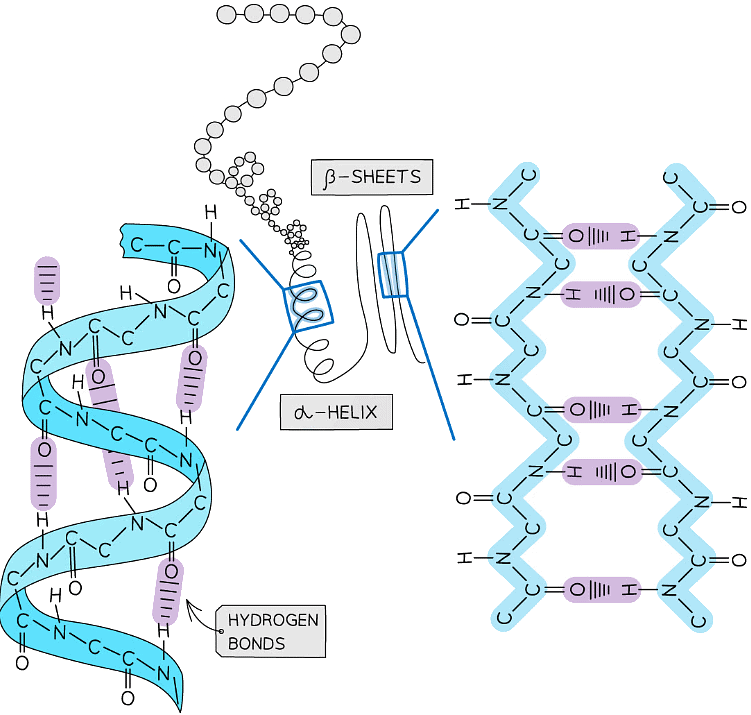 The secondary structure of a protein with the α-helix and β-pleated sheet shapes highlighted. The magnified regions illustrate how the hydrogen bonds form between the peptide bonds
The secondary structure of a protein with the α-helix and β-pleated sheet shapes highlighted. The magnified regions illustrate how the hydrogen bonds form between the peptide bonds
Tertiary
- Further conformational change of the secondary structure leads to additional bonds forming between the R groups (side chains)
- The additional bonds are:
- Hydrogen (these are between R groups)
- Disulphide (only occurs between cysteine amino acids)
- Ionic (occurs between charged R groups)
- Weak hydrophobic interactions (between non-polar R groups)
- This structure is common in globular proteins

The tertiary structure of a protein with hydrogen bonds, ionic bonds, disulphide bonds and hydrophobic interactions formed between the R groups of the amino acids
Quaternary
- Occurs in proteins that have more than one polypeptide chain working together as a functional macromolecule, for example, haemoglobin
- Each polypeptide chain in the quaternary structure is referred to as a subunit of the protein
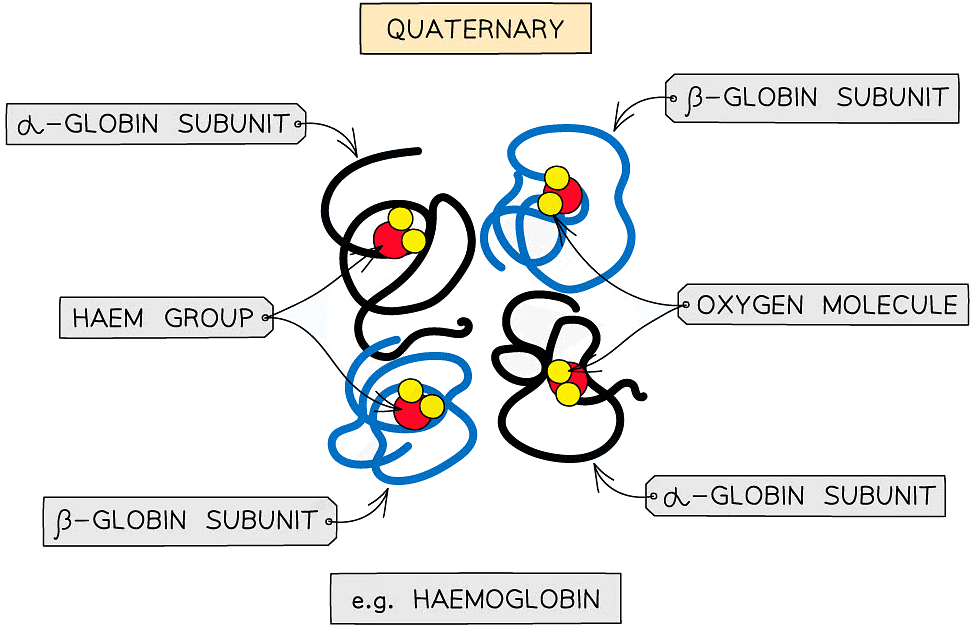
The quaternary structure of a protein. This is an example of haemoglobin which contains four subunits (polypeptide chains) working together to carry oxygen
Summary of Bonds in Proteins Table
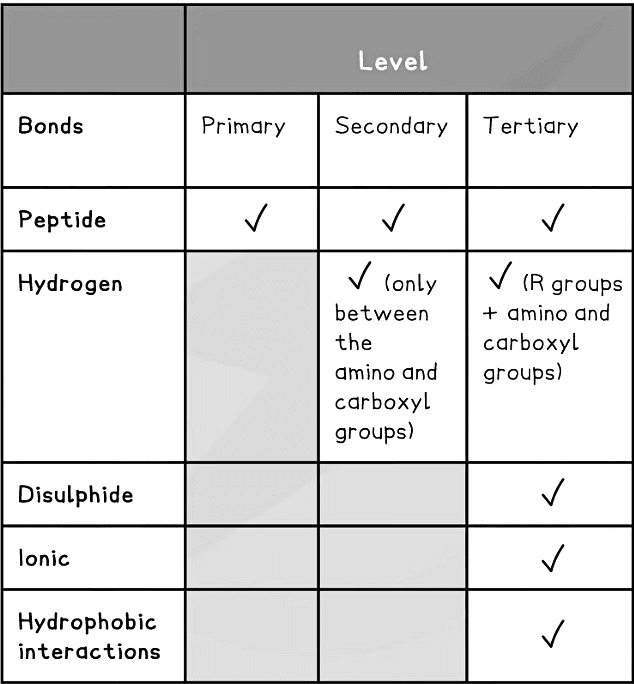
Proteins: Interactions & Shape
- A polypeptide chain will fold differently due to the interactions (and hence the bonds that form) between R groups. The three-dimensional configuration that forms is called the tertiary structure of a protein
- Each of the twenty amino acids that make up proteins has a unique R group and therefore many different interactions can occur creating a vast range of protein configurations and therefore functions
- Within tertiary structured proteins are the following bonds:
- Strong covalent disulfide
- Weak hydrophobic interactions
- Weak hydrogen
- Ionic
 The interactions that occur between the R groups of amino acids determines the shape and function of a protein. These interactions are found within tertiary structures of proteins
The interactions that occur between the R groups of amino acids determines the shape and function of a protein. These interactions are found within tertiary structures of proteins
Disulfide
- Disulfide bonds are strong covalent bonds that form between two cysteine R groups (as this is the only amino acid with an available sulfur atom in its R group)
- These bonds are the strongest within a protein, but occur less frequently, and help stabilise the proteins
- These are also known as disulfide bridges
- Can be broken by reduction
- Disulfide bonds are common in proteins secreted from cells eg. insulin
Ionic
- Ionic bonds form between positively charged (amine group -NH3+) and negatively charged (carboxylic acid -COO-) R groups
- Ionic bonds are stronger than hydrogen bonds but they are not common
- These bonds are broken by pH changes
Hydrogen
- Hydrogen bonds form between strongly polar R groups. These are the weakest bonds that form but the most common as they form between a wide variety of R groups
Hydrophobic interactions
- Hydrophobic interactions form between the non-polar (hydrophobic) R groups within the interior of proteins
Biochemical Tests: Proteins
The biuret test for proteins
- A liquid solution of a sample is treated with sodium or potassium hydroxide to make the solution alkaline
- A few drops of copper (II) sulfate solution (which is blue) is added to the sample
- Biuret ‘reagent’ contains an alkali and copper (II) sulfate
- If a colour change is observed from blue to lilac/purple, then protein is present.
- The colour change can be very subtle, it’s wise to hold the test tubes up against a white tile when making observations)
- If no colour change is observed, no protein is present
- For this test to work, there must be at least two peptide bonds present in any protein molecules, so if the sample contains amino acids or dipeptides, the result will be negative
- The Biuret test is qualitative - it does not give a quantitative value as to the amount of protein present in a sample

A positive colour change produces a lilac/purple colour.
Proteins: Globular & Fibrous
Globular
- Globular proteins are compact, roughly spherical (circular) in shape and soluble in water
- Globular proteins form a spherical shape when folding into their tertiary structure because:
- their non-polar hydrophobic R groups are orientated towards the centre of the protein away from the aqueous surroundings and
- their polar hydrophilic R groups orientate themselves on the outside of the protein
- This orientation enables globular proteins to be (generally) soluble in water as the water molecules can surround the polar hydrophilic R groups
- The solubility of globular proteins in water means they play important physiological roles as they can be easily transported around organisms and be involved in metabolic reactions
- The folding of the protein due to the interactions between the R groups results in globular proteins having specific shapes. This also enables globular proteins to play physiological roles, for example, enzymes can catalyse specific reactions and immunoglobulins can respond to specific antigens
- Some globular proteins are conjugated proteins that contain a prosthetic group eg. haemoglobin which contains the prosthetic group called haem
Fibrous
- Fibrous proteins are long strands of polypeptide chains that have cross-linkages due to hydrogen bonds
- They have little or no tertiary structure
- Due to the large number of hydrophobic R groups fibrous proteins are insoluble in water
- Fibrous proteins have a limited number of amino acids with the sequence usually being highly repetitive
- The highly repetitive sequence creates very organised structures that are strong and this along with their insolubility property, makes fibrous proteins very suitable for structural roles, for example, keratin that makes up hair, nails, horns and feathers and collagen which is a connective tissue found in skin, tendons and ligaments
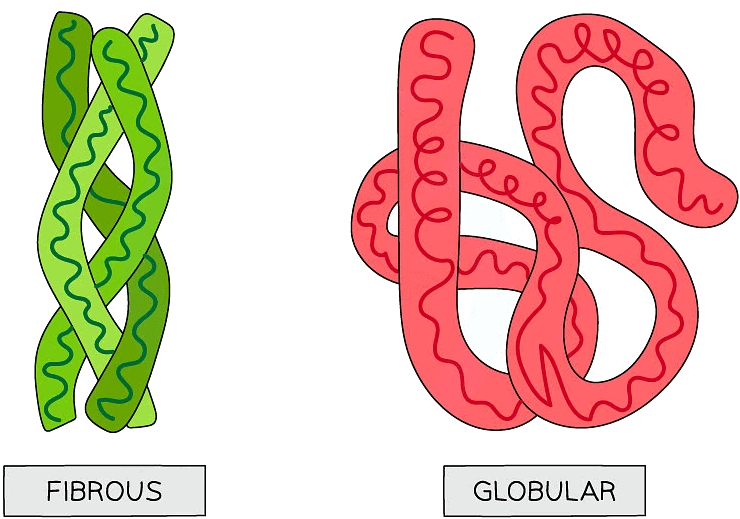
Globular and fibrous protein models illustrating the roughly spherical shape of globular proteins and the long, stranded shape of fibrous proteins
Comparison of Globular & Fibrous Tertiary Proteins Table

The Molecular Structure of Haemoglobin
Structure
- Haemoglobin is a globular protein which is an oxygen-carrying pigment found in vast quantities in red blood cells
- It has a quaternary structure as there are four polypeptide chains. These chains or subunits are globin proteins (two α–globins and two β–globins) and each subunit has a prosthetic haem group
- The four globin subunits are held together by disulphide bonds and arranged so that their hydrophobic R groups are facing inwards (helping preserve the three-dimensional spherical shape) and the hydrophilic R groups are facing outwards (helping maintain its solubility)
- The arrangements of the R groups is important to the functioning of haemoglobin. If changes occur to the sequence of amino acids in the subunits this can result in the properties of haemoglobin changing. This is what happens to cause sickle cell anaemia (where base substitution results in the amino acid valine (non-polar) replacing glutamic acid (polar) making haemoglobin less soluble)
- The prosthetic haem group contains an iron II ion (Fe2+) which is able to reversibly combine with an oxygen molecule forming oxyhaemoglobin and results in the haemoglobin appearing bright red
- Each haemoglobin with the four haem groups can therefore carry four oxygen molecules (eight oxygen atoms)

The structure of haemoglobin showing the α–globin and β–globin subunits, the prosthetic haem group with oxygen molecules bonded to form oxyhaemoglobin.
Function
- Haemoglobin is responsible for binding oxygen in the lung and transporting the oxygen to tissue to be used in aerobic metabolic pathways
- As oxygen is not very soluble in water and haemoglobin is, oxygen can be carried more efficiently around the body when bound to the haemoglobin
- The presence of the haem group (and Fe2+) enables small molecules like oxygen to be bound more easily because as each oxygen molecule binds it alters the quaternary structure (due to alterations in the tertiary structure) of the protein which causes haemoglobin to have a higher affinity for the subsequent oxygen molecules and they bind more easily
- The existence of the iron II ion (Fe2+) in the prosthetic haem group also allows oxygen to reversibly bind as none of the amino acids that make up the polypeptide chains in haemoglobin are well suited to binding with oxygen
The Molecular Structure of Collagen
- Collagen is the most common structural protein found in vertebrates
- In vertebrates it is the component of connective tissue which forms:
- Tendons
- Cartilage
- Ligaments
- Bones
- Teeth
- Skin
- Walls of blood vessels
- Cornea of the eye
- Collagen is an insoluble fibrous protein
Structure
- Collagen is formed from three polypeptide chains closely held together by hydrogen bonds to form a triple helix (known as tropocollagen)
- Each polypeptide chain is a helix shape (but not α-helix as the chain is not as tightly wound) and contains about 1000 amino acids with glycine, proline and hydroxyproline being the most common
- In the primary structure of collagen almost every third amino acid is glycine
- This is the smallest amino acid with a R group that contains a single hydrogen atom
- Glycine tends to be found on the inside of the polypeptide chains allowing the three chains to be arranged closely together forming a tight triple helix structure
- Along with hydrogen bonds forming between the three chains there are also covalent bonds present
- Covalent bonds also form cross-links between R groups of amino acids in interacting triple helices when they are arranged parallel to each other. The cross-links hold the collagen molecules together to form fibrils
- The collagen molecules are positioned in the fibrils so that there are staggered ends (this gives the striated effect seen in electron micrographs)
- When many fibrils are arranged together they form collagen fibres
- Collagen fibres are positioned so that they are lined up with the forces they are withstanding
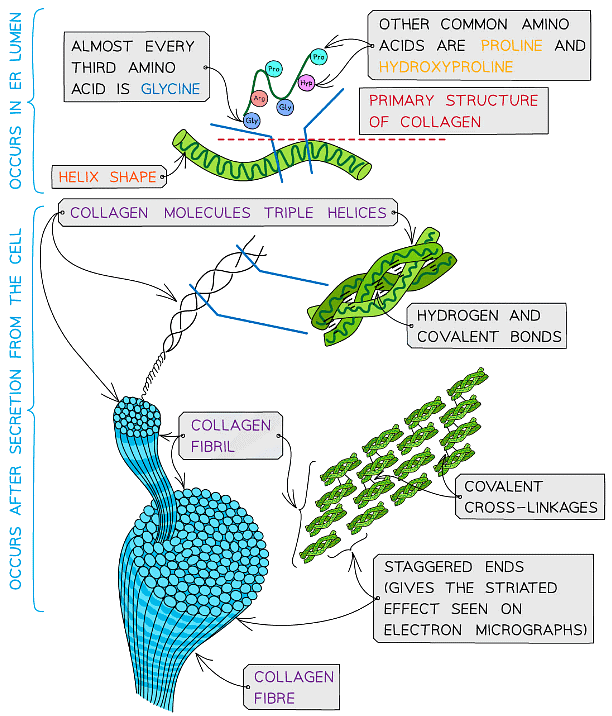
Collagen is a fibrous structural protein that is formed by triple helices collagen molecules arranging into collagen fibrils and finally into collagen fibres which have high tensile strength
Function
- Flexible structural protein forming connective tissues
- The presence of the many hydrogen bonds within the triple helix structure of collagen results in great tensile strength. This enables collagen to be able to withstand large pulling forces without stretching or breaking
- The staggered ends of the collagen molecules within the fibrils provide strength
- Collagen is a stable protein due to the high proportion of proline and hydroxyproline amino acids result in more stability as their R groups repel each other
- Length of collagen molecules means they take too long to dissolve in water (collagen is therefore insoluble in water)
Comparison between Collagen & Haemoglobin Table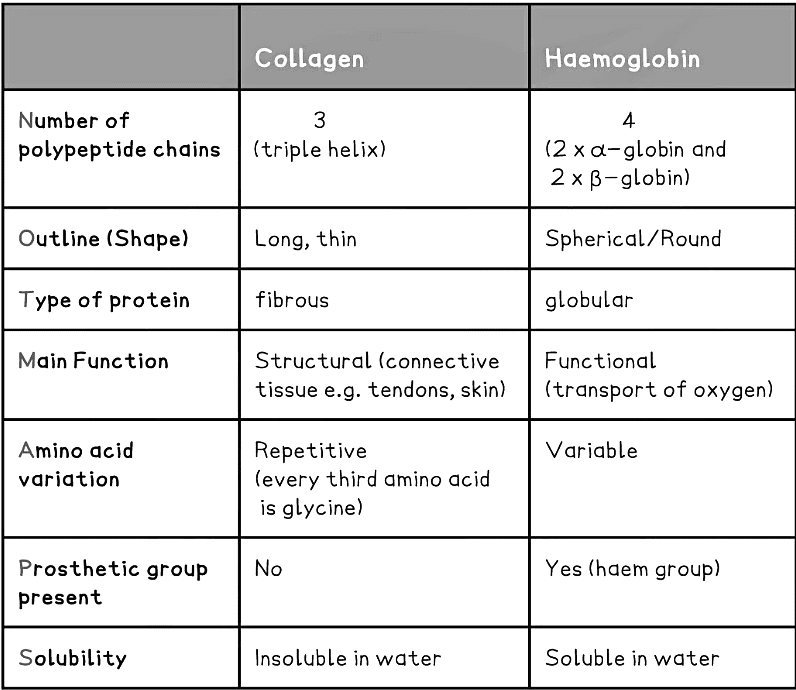
The document Proteins | Biology for Grade 12 is a part of the Grade 12 Course Biology for Grade 12.
All you need of Grade 12 at this link: Grade 12
|
109 videos|127 docs|120 tests
|
Related Searches




















